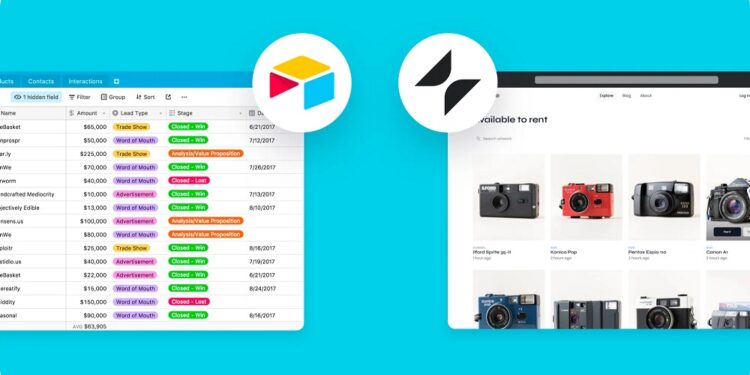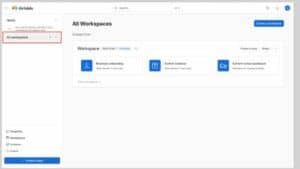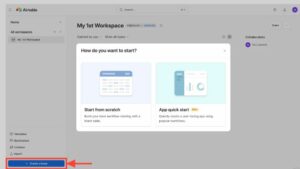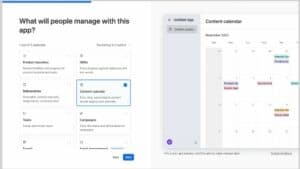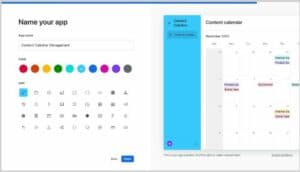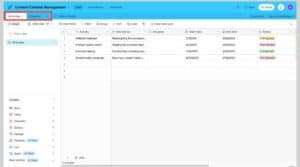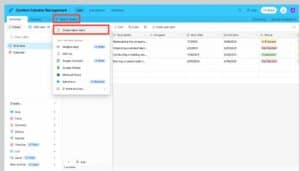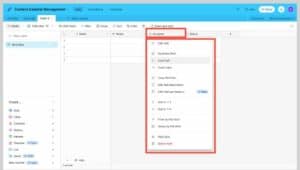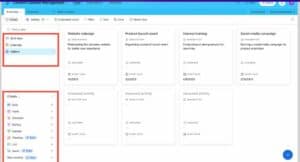How Does Airtable Work will be discussed in this brief article. How does Airtable work? We’re breaking it down from organizing your projects into workspaces to diving deep into data with tables, fields, and records. Airtable is changing how we handle projects and data. This no-code platform is as easy to use as preadsheet but as powerful as a database. It helps teams organize, share, and track work effortlessly.
How Does Airtable Work? Complete Guide In 2024
In this article, you can know about How Does Airtable Work here are the details below;
But how does Airtable work? In this blog, we’ll break down everything. From organizing your projects into workspaces to diving deep into data with tables and fields, we make it simple. Ready to see how Airtable can make your work easier? Let’s get started!
What is Airtable?
Airtable is a hybrid tool combining databases and spreadsheets. It is a relational database platform that enables organizations to manage business processes, from tracking marketing campaigns to product roadmaps, on a single platform.
If you want to know more about this tool, read our comprehensive blog on: What is Airtable?
How Does Airtable Work?
Airtable, one of the best no-code tools, works based on the following components. They are:
If you want to create something using Airtable, follow the below steps.
1. Create a Workspace
Creating a workspace in Airtable is the first step. A workspace acts like a digital room where you can store related projects. You can set up a workspace by signing into Airtable and following simple instructions. Each workspace can hold multiple bases, similar to folders. It is ideal for organizing various projects or aspects of work.
You will see all the workspaces once you land on your Airtable homepage. To create a new workspace, follow the below instructions:
- Navigate to the upper left corner of screen.
- Click on the “Create a Workspace” icon (+ Icon)
- Name it as you want.
That’s it. You are done.
2. Add Bases
Once your workspace is set up, you can add Bases. Within each workspace, you’ll find Bases. A Base is your project’s home, holding all the data you need. It’s organized into tables, records, and fields, making it easy for you to navigate through your project’s information.
To add a new Base, follow the instructions below:
- Look at the lower-left corner of your screen.
- Hit the “Create a base” button.
- Or you can import your Base, use pre-built templates, or start from scratch. If you are using Airtable for the first time, going with the templates will be a good idea.
- If you want to use a pre-built template, click the “App quick start” option and select what kind of App you need. For example: Marketing & Creative, Product Development, Project Management, etc.
- After that, specify what type of things you want to manage with it. You can choose up to the 5 items from the provided list. Here, I’ve selected the “Content Calendar” option.
- Then, hit the “Next” button. You can even go back to change the setting.
- Name your App, pick a template color and Icon.
- At last, click the “Finish” button. That’s it!
3. Design Tables and Add Records
We know bases consist of tables, and tables are made of records. Designing tables involves deciding what kind of information each table will hold. In the below screenshot, I’ve created 2 tables named Activities and Channels under the Content Calendar Management base.
To add or import an Airtable table, click the + Icon labeled “Add or import.” If you want to add a blank table, select “Create blank table.” Or you can import from other sources.
Each row in a table is a record, and each record can represent an item, a task, or an entry. You can define what each record contains, making it easy to structure and access data. Also check Apps To Invest In Mutual Funds
Ways to add a new Airtable record:
- Click on the (+) Plus Icon from the left-bottom corner of the screen.
- There is also a shortcut way to add a new record. Select an existing record and then press the Shift+Enter/return keys together to do it.
4. Customize Fields and Set Up Views
Customize your Fields with different types of data, such as text, numbers, dates, or even attachments to store your information.
Here, I’ve created a new table where Assignee is a Field. You can duplicate any field, insert left or right, sort them, and more.
Then, set the View you prefer. To create a new View, click on the + Icon of any item under the Create section. Name it, and you can also control the collaboration option.
Popular Airtable Use Cases
Are you wondering how does Airtable work? Here, I’m giving you some of the most popular Airtable use cases:
1. Content Management for Website Creation
Airtable can be utilized as a dynamic content management system (CMS) for websites. Users can store and manage website content like blog posts, product listings, and media files. Through API integration, Airtable enables real-time content updates on websites, making it an excellent tool for web developers and content creators.
2. Customer Relationship Management (CRM)
Airtable is extensively used as a CRM tool. It allows sales teams to organize prospects, track deals, and manage sales operations effectively. This functionality is particularly beneficial for marketers who need to efficiently manage and organize customer relationships.
3. Project Management
With its flexible structure, Airtable serves as an effective project management tool. Teams can track tasks, assign responsibilities, set deadlines, and monitor the progress of various projects. Its collaborative features of the enable team members to work together seamlessly.
4. Event Planning
The platform is ideal for managing the complex logistics of event planning. Users can organize event schedules, vendor contacts, guest lists, and budgets. Its visual and collaborative features simplify the coordination and execution of events, large or small.
5. Inventory Management
Businesses use Airtable for tracking inventory levels, product orders, and supply chain information. Customizable fields and views allow for detailed tracking of stock, order statuses, and vendor information, making it a valuable tool for retail and e-commerce operations.
Is Airtable free?
Yes, Airtable offers a free tier with limited features. The free plan includes a certain number of records per Base and essential features.
Can Airtable integrate with other apps?
Yes, Airtable offers integration capabilities with various other apps and tools, enhancing its functionality and application in different business processes. You can easily integrate Airtable with Dorik to create any website.
Is Airtable suitable for large organizations?
Absolutely, Airtable is designed to cater to both small teams and large organizations, offering scalable solutions for managing complex data and processes.
Does Airtable support collaboration among team members?
Yes, it supports. Airtable is designed for collaboration, allowing team members to work together in real-time, share views, and keep everyone updated.
How secure is data stored in Airtable?
Airtable prioritizes data security, offering features like permission settings and data encryption to protect your information.
Are there any free alternatives to Airtable?
Here are some free alternatives to Airtable:
- Google Sheets
- Notion
- Asana
- Trello
- Rows
- Stackby
Wrapping Up
Airtable stands out as a simple yet powerful tool for managing and organizing data. With its easy-to-use interface and flexible structure, it transforms complex data management into a smooth, efficient process.
Whether for personal projects or team collaboration, Airtable’s customizable features ensure that organizing and accessing your data is effortless and effective. Also check Employee Time Tracking Apps
We hope our guide on how does Airtable work has shown you every step of using this tool. However, if you have any suggestions, share them in the comment section.

